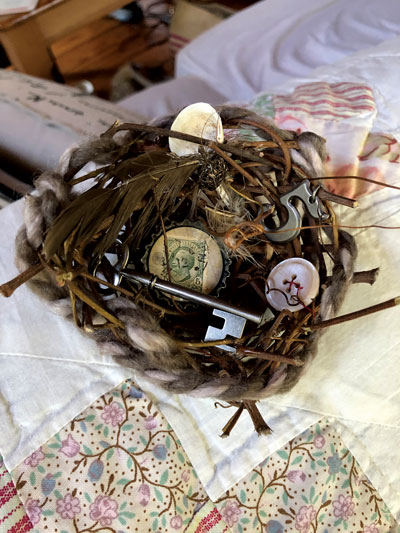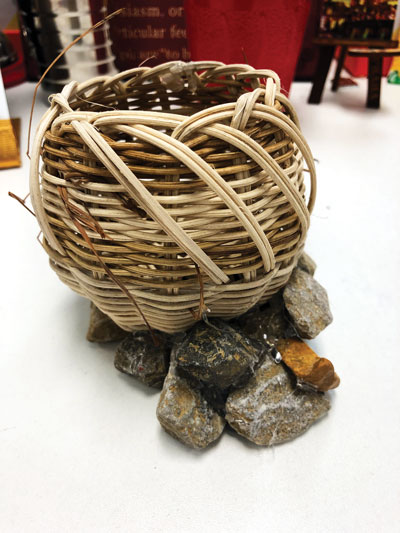 |
 |
 |
| Top to bottom: Nora Kate Duell, nature nest with found butterfly wing. Baskets drying out in the sun. Elise Hendrix weaving her horse’s hair into her basket. |
I took a basket weaving workshop at the 2018 Virginia Art Education Association Conference, and it was fascinating! I wanted to bring that skill to my eighth-grade honors art students, but I also wanted to connect it to something more than the skill itself.
Weaving a Nest
Inspired by a bird who whisked away a sprig of rosemary from my herb garden to add to its nest, I began thinking about the concept of nests. I remembered hearing a story of how magpies gather shiny objects for their nests, such as jewelry (research has debunked this theory, but it’s still nice to think about). I also remembered my Aunt Sibyl Hays telling me she would put the ends of her embroidery threads on a table in her backyard and watch the birds gather the yarn.
I was at our lake house when the idea came to me to weave a nest. I remembered seeing wild vines nearby, and I gathered some of them. Next, I found a tutorial on YouTube on how to make a bramble basket from natural vines. After weaving the nest, I attached objects to it that were connected to being with my family at the lake: a shell my grandson gathered from the shallow water, a feather I found in the grass, a key to represent that our door was always open to guests, and a metal number five for the number of people in my family.
Gathering Nature
It took more of the vine to make the nest than I imagined, so I knew I would need to acquire many basketmaking materials for students. I ordered a basketmaking kit that included instructions for weaving a Cherokee double-wall basket and enough reeds for forty baskets. I then asked a student whose family owns a nursery if he would donate some type of berry vine. I opened my classroom one day to find a huge bundle of vines he had gathered! Students also collected pine needles and grasses.
Baskets and Nests
I discussed with students the history of basketry, focusing on basketry of indigenous people. I shared a video of Cherokee National Treasure weaver Bessie Russell, in which she discusses the legacy of basket weaving she is sharing with a new generation of weavers. Students knew in advance that their baskets would be transformed into themed nests, so they brainstormed a theme to which they felt connected.
Day One and Introducing Materials
Before class, I cut all of the reeds into the lengths required and placed them into clearly marked dish tubs for every four students. There were tubs for each type of reed that would be used (34" spokes, 21" spokes, and a tub for the long strands). I had filled these tubs with water towards the end of the previous class because the reeds needed to soak for approximately twenty minutes prior to weaving.
While the reeds were soaking, we watched a short tutorial on weaving. When students were ready to weave, I played it again, stopping it intermittently and demonstrating it myself using my document camera. My goal that first day was for students to complete the base of their baskets.
 |
 |
 |
| Melody Weintraub, Nest of Lake Memories, woven with muscadine vine. Melody Weintraub, tiny basket woven with reeds and vines. Jake Bridgmon, Mountain Home. |
Day Two to Day Ten
Each day of weaving thereafter, students set up the weaving themselves by filling their tubs with water and placing the weavers in the tubs. They also needed to soak their baskets again to make the reeds pliable. As they continued weaving, I monitored them until they were comfortable with the process.
Embellishing the Nests
Students began bringing in objects for their nests even before the baskets were finished. Some added the embellishments by weaving them into the wall and along the rim of the baskets. I encouraged them to draw out the plan for the nest before starting. That way, they could determine what objects they would need to bring. When students could not find the right objects to include, they hand-made them.
Presenting the Nests
Students loved sharing the stories about their artful nests. Some even created a display for them, bringing in branches and pieces of driftwood on which to balance them. Each student then wrote a statement about the meaning of their nest.
A quote from the Cherokee Nation Cultural Resource Center says, “A basketmaker uses no patterns, models, or drawings. Her patterns are in her soul, in her memory, and imagination.” Perhaps basketry is a skill that will not only draw our art students closer to nature, but also allow them to share memories, process emotions, and celebrate their own imaginations.
Melody Weintraub teaches middle-school art at Briarcrest Christian School in Eads, Tennessee. She is currently president-elect of the Tennessee Art Education Association. melodyweintraub@gmail.com
NATIONAL STANDARD
Presenting: Convey meaning through the presentation of artistic work.
WEB LINK
Author Website: www.melodyweintraub.com
View this article in the digital edition.







